The aggressive judgment towards unmarried women and women without children is especially visible in satirical cartoons which rely on exaggeration
unmarried women
The illustrations presented below are meant to highlight how unmarried women have been vilified and mocked since the 18th century.
Exaggerated features: single women as unattractive women
In these caricatural portraits from the 18th to early 19th century, single women are portrayed as unattractive – or even downright hideous – women who treat their cats as substitutes for the babies they never had.

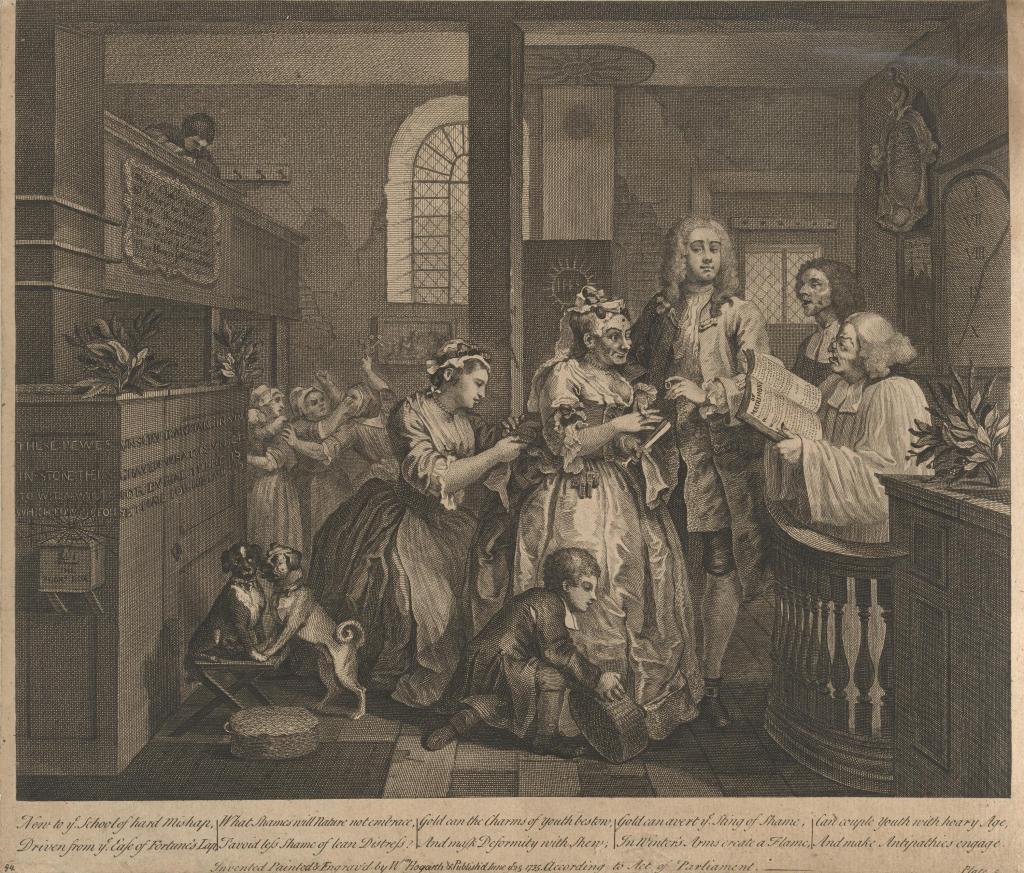
In this close-up, the physical exaggeration of the old maid‘s facial features (in order to make her look unattractive) compared to the relatively average-looking groom and maid is evident.

In the illustration below, it seems like the subject whose back is turned towards us might be a younger woman, given her smaller stature, darker hair, and the lack of headscarf. This highlights the fact that stereotypes about unmarried women usually portray older or even aging women even though an old maid could be as young as 25 years old.


Unloved and unmarried: suffragettes as bitter women
As the women’s rights movement took hold, suffragettes became associated with the stereotype of the single woman who is bitter because she never married, as seen in the below illustration. This added a new layer to the negative perception of unmarried women, compared to previous centuries.
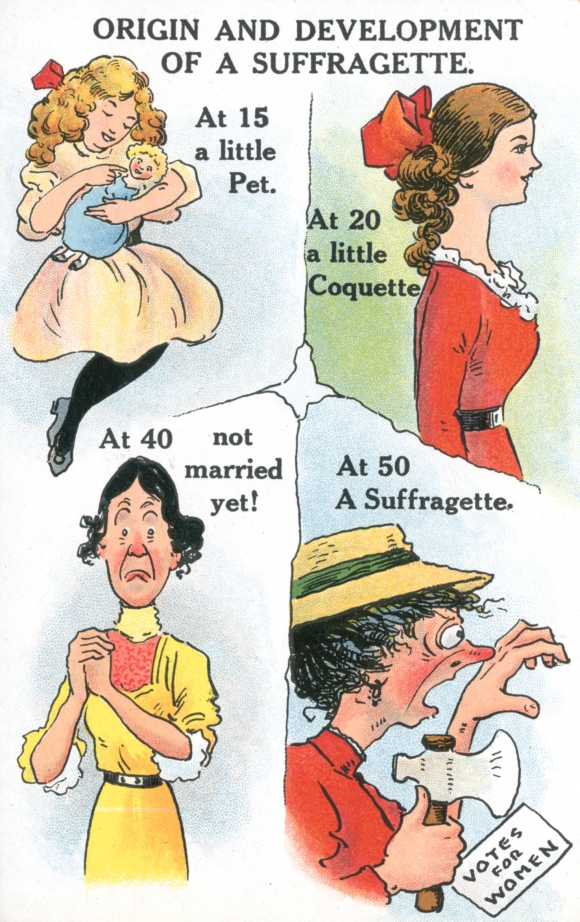
The two postcards below contrast the devoted housewife who works for her husband’s benefit with the single woman. Women are warned: “Don’t become a cross old maid. If you can’t get anyone to marry try to live like other women. Don’t show your disappointment.”


Don’t be afraid of housework and Don’t become a cross old maid – Catherine Palczewski Postcard Archive
The following rhymes on this postcard titled “To a Suffragette,” are meant as a warning to the unmarried suffragette:
While you remain a suffragette
A Valentine you’ll never get
What man would ever want a wife
Who spends in prison half her life.

women without children
The childless as an object of pity and the spiritual superiority of motherhood
’tis better to be lowly born,
William Shakespeare and John Fletcher, Henry VIII, Act II, scene 3
And range with humble livers in content,
Than to be perk’d up in a glistering grief,
And wear a golden sorrow.
This verse from Shakespeare’s Henry VIII play seemingly inspired the painting titled My Lady Is a Widow and Childless (c.1874), by Marcus Stone.
In the foreground of the painting, a happy couple enjoys the company of their two children while in the background, the shadowy figure of an older woman, alone and dressed in black, watches them, her body language expressing longing or sentimentality. From their clothing and from the gardening tools at their feet, it appears that the couple is working class. From the title of the artwork and implied through the ongoing contrast between the subjects, it is clear that the woman is a wealthy widow. Although the title focuses on the childless widow, she is actually barely visible in the painting, which is surprising.
This painting highlights a preconceived notion that still exists today, which is that as long as you are a wife and mother, you will be fulfilled, even if you are poor. By contrast, it also suggests that the absence of a husband and children will create an overwhelming loneliness that will make the wealthy envy poor and lower-class parents.
This dual idea that the difficulties of life will be eased by the tenderness of parenthood and that material wealth (some of which might be the result of not having to bear the cost of raising children) is worthless compared to the value of parenthood is a damaging and limiting view, for both parents and non-parents.

Basked in light, the couple with children is so prominent in the painting that it feels that a cropped close-up is necessary to be able to really discern the widow in the background, especially since she is portrayed in the shadows.

Another example of the opposition between childlessness/material wealth and parenthood/blessedness/poverty can be found in Niko Pirosmani’s painting Childless Millionaire and a Poor Woman Blessed with Children (1910). As explicitly stated in the title, it shows an extremely affluent couple without children standing on the left of the painting, with an impoverished mother with three children standing on the right. Both groups are looking at each other. Although all subjects are dressed in black, there isn’t any emotional value assigned to any of their position, body language, or facial expressions. The couple without children and the mother with her children each take the same amount of space on the canvas, are painted with the same colors, and seem to be smiling. It is only the title itself, which implies a more positive view of the poor woman as she is blessed, that informs the viewer about how each subject is meant to be perceived.
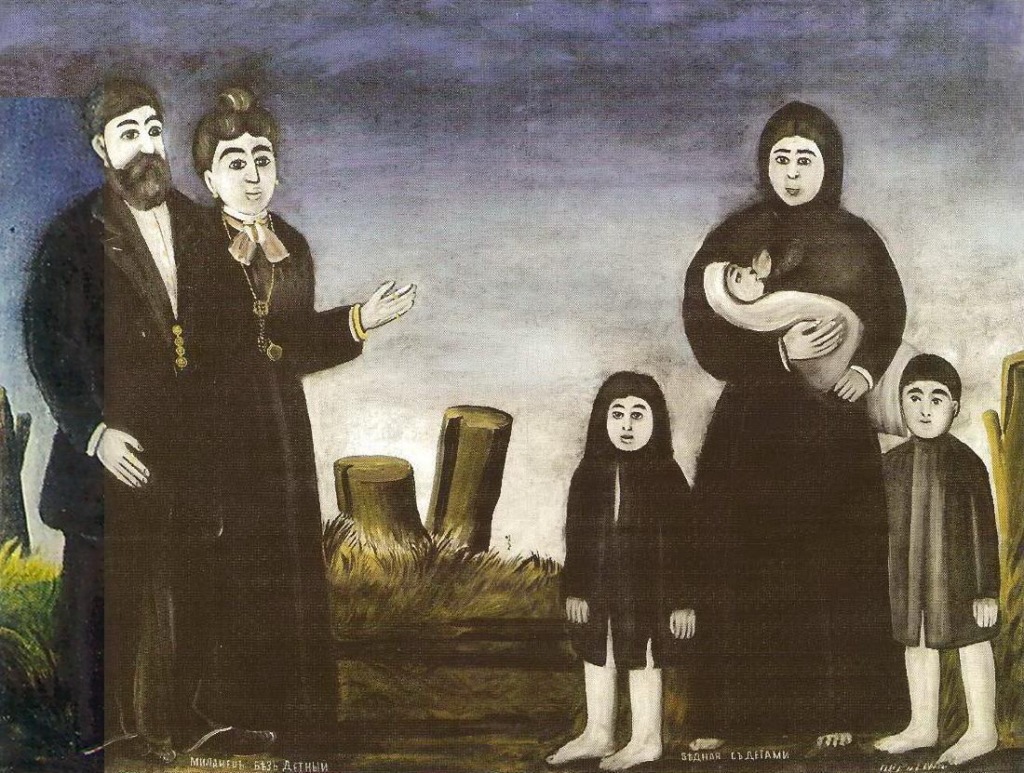
Non-motherhood as a failure to perform civic duty
The politicization of motherhood in the late 19th century and early 20th century resulted from tensions that emerged due to large-scale immigration (especially in the U.S.), fears of population decline (especially in Europe after World War I), and the rise of the women’s rights movement.
Motherhood was no longer only a reflection of personal morals or spiritual superiority. It became a civic duty for women, in order to fulfill gender roles and increase the (white) birthrate.
In the vintage postcard below, in which two little girls holding baby dolls stare at a pretentious-looking little girl pulling a dog toy behind her, the caption states: “Isn’t this race suicide just awful!” The message is clear: women who are choosing not to have babies are contributing to “race suicide” (an alarmist, xenophobic, and racist perception that white people were being outnumbered by foreigners and people of color). This new wave of propaganda specifically targeted women who tried to control their reproductive functions through various contraceptive and abortifacients methods.
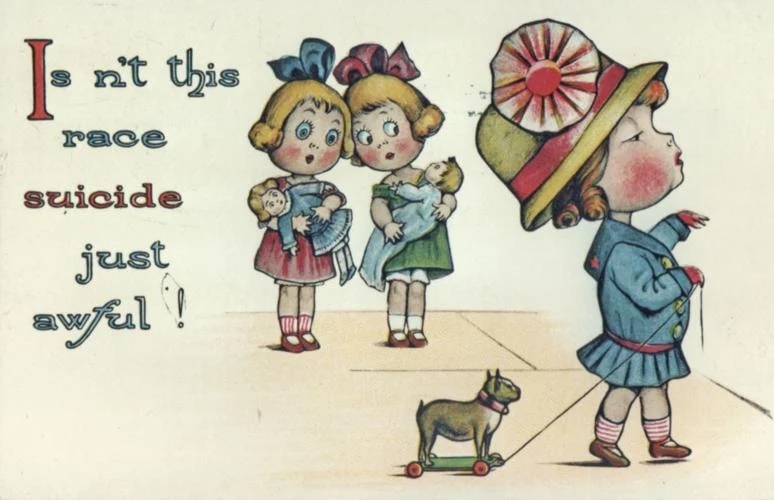
Opponents of the women’s rights movement tried to pressure women who were getting involved in politics by associating the suffragettes with unfit mothers (who abandon their children and husband) and bitter spinsters.
In the below postcard, the two contrasting scenes are meant to emphasize the essential role of motherhood in women’s lives, by opposing the participation at a rally for women’s right to vote (which is captioned “she is not doing that”) with the picture of a mother sitting at home holding a baby. One is an unruly woman, the other is a devoted one. This idea that a woman was only a good mother (and wife) if she stayed home was a recurring theme in anti-suffrage postcards. For women without children, whether by circumstance or choice, this leitmotiv implied that engaging in activism and avoiding the responsibilities of motherhood made them unwomanly, and if unmarried, unappealing as potential wives.
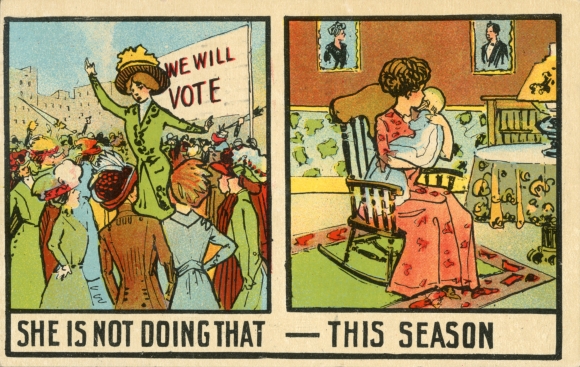
Taking things one step further, this last postcard is representative of the view that some women were undeserving of motherhood – effectively blaming couples for their own childlessness. Meant to congratulate new parents on the birth of their child, this card also attacks those deemed unworthy or underserving of becoming parents, with the stork stating “I don’t come to suffragettes and the strong-minded. Back up and fade away ye childless.”
After seeing the extent of these caricatures, satirical cartoons, and stereotypes, it seems even more essential to be able to view neutral or positive portraits of childless and childfree women, including self-portraits.
